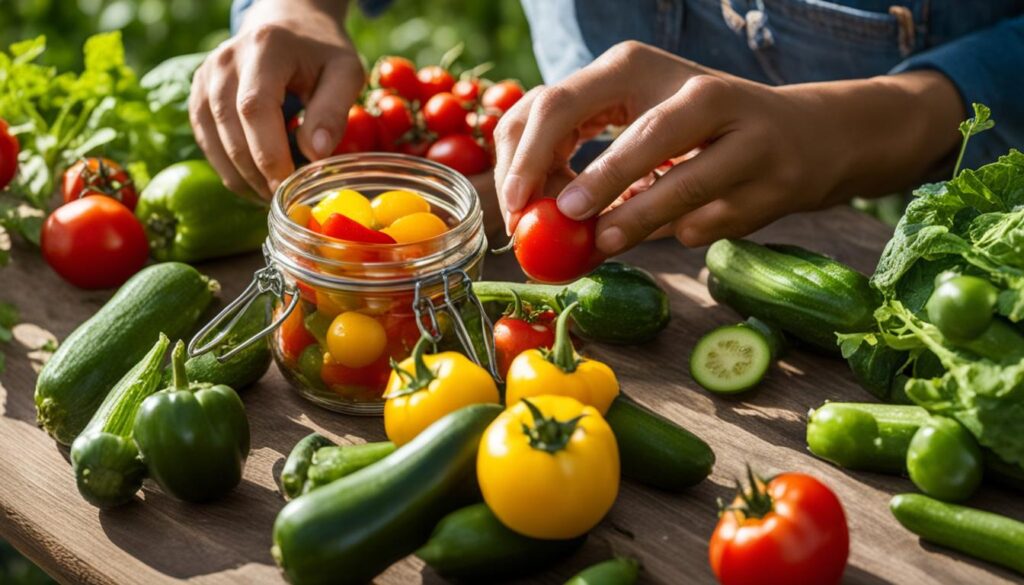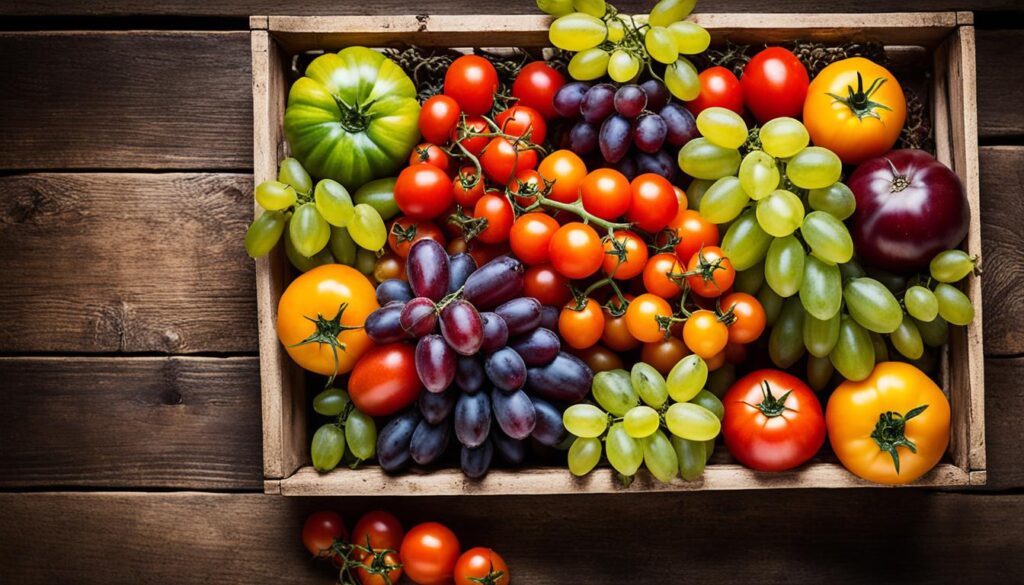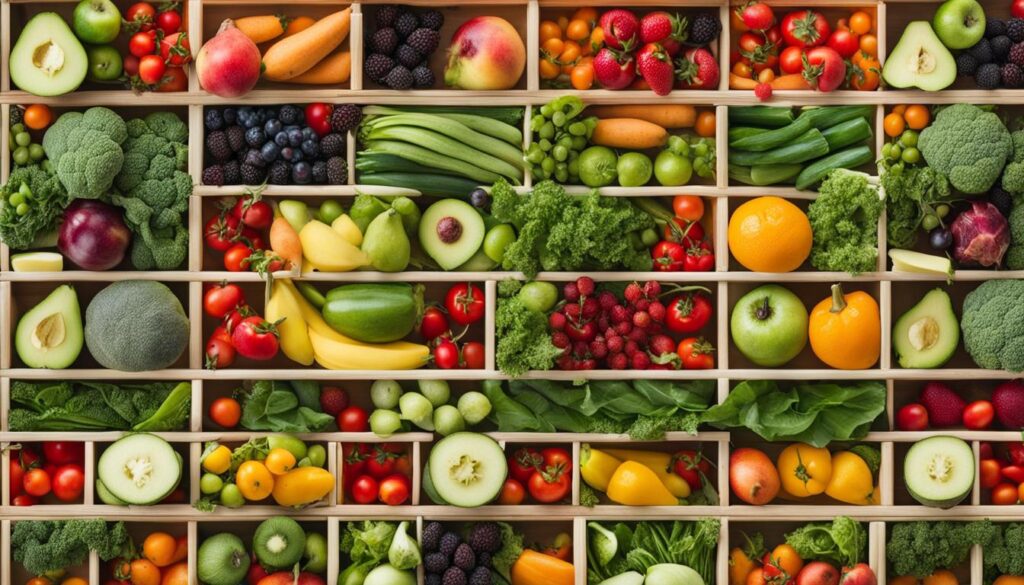Are you tired of the same old meals and searching for a way to add variety and freshness to your plate? Look no further than seasonal eating! I’m here to guide you on a delicious journey through the changing seasons, where you can discover an abundance of flavors using the freshest ingredients.
Seasonal eating is not only a culinary adventure but also a pathway to a healthier lifestyle. By embracing the bounty of each season, you can nourish your body with wholesome and nutrient-dense foods that are specifically designed by nature to support our wellbeing.
Key Takeaways:
- Seasonal eating provides an opportunity to explore a wide variety of fresh and flavorful recipes throughout the year.
- By incorporating seasonal ingredients, you can enjoy the benefits of enhanced taste, higher nutritional content, and support for local farmers.
- Seasonal eating can help you reduce your grocery expenses by taking advantage of lower prices during peak harvest times.
- Meal planning and a change in mindset are essential in incorporating seasonal produce into your everyday meals.
- Preserving seasonal produce allows you to enjoy the flavors of each season even when they are no longer readily available.
Benefits of Eating Seasonally
Eating seasonally offers a myriad of advantages that contribute to your overall well-being. Not only does it enhance the taste and nutritional value of your meals, but it also supports the local economy and helps you save money on your grocery bill. Let’s explore these benefits in more detail:
Fresher and More Nutritious Produce
When you consume fruits and vegetables that are in-season, you can be assured of their freshness and higher nutrient content. In-season produce is often harvested at its peak, meaning it has had more time to ripen and develop its full flavors and nutritional profile. This results in a more vibrant and satisfying dining experience.
Supporting the Local Economy
By choosing to eat seasonally, you can directly support local farmers and contribute to the growth of your local economy. When you purchase from farmers markets or subscribe to community-supported agriculture (CSA) programs, you help sustain small-scale farmers who rely on local sales to thrive. This helps create jobs and ensures a robust and sustainable food system.
Cost Savings
One of the significant benefits of eating seasonally is the potential for cost savings. When fruits and vegetables are in abundance during their peak season, their prices tend to be lower compared to when they’re out of season. By taking advantage of these lower prices, you can stretch your grocery budget and also enjoy a wider variety of produce.
“Eating seasonally allows you to savor food at its best – bursting with flavor and packed with nutrients. Embrace the flavors of each season and nourish your body while supporting local communities.”
Seasonal eating is not only a culinary adventure but also a mindful choice that promotes a healthier lifestyle. So, let’s go ahead and explore the wonders of each season while benefiting our taste buds, our community, and our wallets.
Tips for Eating Seasonally
If you’re ready to embark on a journey of seasonal eating, here are some helpful tips to get you started:
1. Meal Planning
Meal planning is a key component of incorporating seasonal ingredients into your meals. By thinking ahead and organizing your meals for the week, you can ensure that you have the necessary seasonal produce on hand and avoid food waste. Consider creating a weekly meal plan, making a shopping list, and purchasing ingredients that are currently in season.
2. Embrace Mindset Change
Changing your mindset is vital when it comes to eating seasonally. It’s about recognizing the value of fresh and locally sourced ingredients. By appreciating the flavors and nutritional benefits of seasonal produce, you’ll be more motivated to incorporate them into your meals. Get excited about exploring new flavors and experimenting with different recipes.
3. Start with Simple Recipes
If you’re new to seasonal eating, starting with simple recipes is a great way to ease into the process. Look for recipes that highlight the natural flavors of seasonal ingredients without overwhelming them with complex techniques or excessive ingredients. Simple recipes allow the natural goodness of the produce to shine through and make the transition to seasonal eating much easier.
4. Preserve Your Produce
When you have an abundance of seasonal produce, it’s important to preserve them to enjoy their flavors even when they’re out of season. Canning, freezing, pickling, drying, and fermenting are all effective methods of preserving produce. These preservation techniques allow you to enjoy the taste of seasonal ingredients throughout the year, even when they’re no longer available locally.
“Meal planning, embracing a new mindset, starting with simple recipes, and preserving produce are all key aspects of successful seasonal eating.”
By following these tips, you’ll be well on your way to embracing seasonal eating and reaping the benefits of fresh, flavorful, and nutritious meals.

What’s in Season Now?
Curious about what fruits and vegetables are in season right now? Knowing what’s in season can inspire you to use fresh and flavorful ingredients in your recipes. The produce that is in season may vary depending on where you live, so it’s always a good idea to check your local farm or farmer’s market to see what they are producing. You can also consult a state-by-state seasonal food guide for a comprehensive list of what’s in season in your area.
For example, let’s take a look at some of the seasonal produce that you can find in January:
| Seasonal Produce |
|---|
| Beets |
| Broccoli |
| Cabbage |
| Citrus fruits |
| Kale |
| Winter squash |
These fruits and vegetables are at their peak freshness and flavor during this time of year. Incorporating them into your meals can add variety and nutrition to your diet.

Seasonal Recipes for Each Month
Each month offers a delightful array of seasonal produce, providing endless possibilities for creating delicious and flavorful recipes. Whether you’re a culinary enthusiast or simply looking to incorporate more fresh ingredients into your meals, here are some recipe ideas showcasing the best produce available each month.
February Recipes:
February brings an abundance of nutritious ingredients to savor. Embrace the flavors of the season with these recipe ideas:
| Produce | Recipe Ideas |
|---|---|
| Broccoli | Broccoli and Cheddar Soup, Roasted Broccoli with Garlic |
| Brussels Sprouts | Roasted Brussels Sprouts with Balsamic Glaze, Brussels Sprouts Salad |
| Grapefruit | Grapefruit Avocado Salad, Grilled Grapefruit |
| Kale | Kale Caesar Salad, Sautéed Kale with Garlic |
| Sweet Potatoes | Roasted Sweet Potato Wedges, Sweet Potato and Black Bean Chili |
March Recipes:
March ushers in the arrival of fresh spring produce. Try these delicious recipes with the seasonal ingredients of the month:
| Produce | Recipe Ideas |
|---|---|
| Asparagus | Grilled Asparagus with Lemon, Asparagus and Mushroom Risotto |
| Avocados | Avocado Toast, Guacamole |
| Mushrooms | Vegetarian Mushroom Stroganoff, Stuffed Mushrooms |
| Oranges | Orange Chicken, Winter Citrus Salad |
| Spring Peas | Pea Soup, Pasta with Peas and Pancetta |
With recipes like these, you can enjoy the freshest ingredients each month while adding variety and flavor to your meals. Don’t be afraid to experiment and get creative in the kitchen with the bountiful produce nature provides!

Summer Recipes and Refreshing Drinks
Summer is the perfect time to indulge in a variety of fresh and vibrant recipes that capture the essence of the season. Whether you’re hosting a BBQ, going on a picnic, or enjoying a leisurely al fresco dining experience, there are endless possibilities for delicious and satisfying meals.
Start your summer feast with light and refreshing salads that showcase the best seasonal produce. Mix crisp greens, juicy tomatoes, and tangy dressings to create a medley of flavors that are sure to tantalize your taste buds. Add a touch of sweetness with fresh berries or tropical fruits to elevate your salad game to a whole new level.
If you’re in the mood for something heartier, fire up the grill and sizzle some marinated meats or succulent fish. The smoky aroma and charred flavors will transport you to a summer paradise. Pair your grilled delights with mouthwatering sides like corn on the cob, grilled vegetables, or a zesty pasta salad.
And let’s not forget about the drinks! Stay cool and hydrated with a selection of refreshing beverages that are perfect for hot summer days. Sip on a fruity punch bursting with tropical flavors, or treat yourself to a classic gin cocktail garnished with fresh herbs. For a more relaxed vibe, enjoy a glass of homemade cordial or a chilled juice blend packed with vitamin-rich ingredients. And if you’re looking for a fun and icy treat, indulge in a cooling slushie that will quench your thirst and leave you feeling refreshed.
With so many options to choose from, summer recipes and refreshing drinks are sure to elevate your outdoor dining experience and create unforgettable moments with family and friends.
Top Summer Recipes
| Recipe | Description |
|---|---|
| Grilled Pineapple Chicken Skewers | A delicious blend of tangy pineapple and juicy chicken, perfectly grilled to perfection. |
| Watermelon Feta Salad | A refreshing combination of sweet watermelon, salty feta cheese, and fresh mint leaves. |
| Citrus Shrimp Tacos | Light and zesty shrimp tacos topped with a citrusy slaw and creamy avocado salsa. |
| Caprese Pasta Salad | A classic Italian salad with fresh tomatoes, mozzarella, basil, and pasta, tossed in a tangy vinaigrette. |
| Strawberry Lemonade | A thirst-quenching drink made with ripe strawberries, tart lemons, and a hint of sweetness. |
| Mango Margarita | A tropical twist on a classic margarita, made with fresh mango puree and a splash of lime. |

Winter Comfort Foods
Winter is the perfect time to indulge in comforting and hearty dishes that warm both the body and the soul. Whether you prefer slow-cooked roasts, creamy soups, or delicious casseroles, winter recipes are sure to satisfy your cravings for comfort foods. With a focus on using seasonal ingredients, these recipes are not only delicious but also nourishing. Let’s explore some winter favorites that will bring comfort to your table.
Roast Chicken with Pilaf
One classic winter recipe is a succulent roast chicken served with a flavorful pilaf. The juicy and tender chicken, with its crispy golden skin, pairs perfectly with the fragrant rice pilaf. This dish is not only comforting but also versatile to customize with your favorite herbs and spices. Here’s a simple recipe to get you started:
“Roast Chicken with Pilaf Recipe”
Serves 4 | Prep Time: 15 minutes | Cook Time: 1 hour 30 minutes
- 1 whole chicken
- 2 tablespoons olive oil
- 1 teaspoon salt
- 1/2 teaspoon black pepper
- 1 onion, finely chopped
- 2 cloves garlic, minced
- 2 cups long-grain rice
- 4 cups chicken broth
- 1 tablespoon dried herbs (such as thyme or rosemary)
1. Preheat the oven to 375°F (190°C).
2. Rub the chicken with olive oil, salt, and black pepper.
3. Place the chicken in a roasting pan and roast for about 1 hour and 30 minutes, or until the internal temperature reaches 165°F (74°C).
4. While the chicken is roasting, sauté the onion and garlic in a separate pan until translucent.
5. Add the rice, chicken broth, and dried herbs to the pan with the onion and garlic. Bring to a boil, then reduce the heat and simmer until the rice is cooked and the liquid is absorbed.
6. Serve the roast chicken with the pilaf and enjoy!
Baked Whole Salmon
Another delightful winter recipe is the baked whole salmon. This impressive dish not only makes a stunning centerpiece for your table but also provides a rich and satisfying meal. The combination of perfectly cooked salmon, aromatic herbs, and tangy citrus flavors creates a harmonious and comforting taste experience. Here’s a recipe to try:
“Baked Whole Salmon Recipe”
Serves 6 | Prep Time: 15 minutes | Cook Time: 30 minutes
- 1 whole salmon, cleaned and scaled
- 2 lemons, sliced
- 1 bunch fresh dill
- 2 cloves garlic, minced
- 2 tablespoons olive oil
- 1 teaspoon salt
- 1/2 teaspoon black pepper
1. Preheat the oven to 400°F (200°C).
2. Place the salmon on a large baking sheet lined with parchment paper.
3. Stuff the cavity of the salmon with lemon slices and fresh dill.
4. In a small bowl, mix together the minced garlic, olive oil, salt, and black pepper.
5. Brush the seasoned oil mixture over the entire salmon, making sure to coat it evenly.
6. Bake the salmon for about 30 minutes, or until the flesh is opaque and flakes easily with a fork.
7. Serve the baked whole salmon with your favorite side dishes and enjoy!
Root Vegetables and Hearty Soups
Winter is also the time to appreciate the abundance of root vegetables and hearty vegetables that thrive in the colder months. These ingredients lend themselves perfectly to comforting soups, stews, and casseroles. By combining flavorful vegetables like carrots, potatoes, parsnips, and turnips with aromatic herbs and warming spices, you can create wholesome and satisfying dishes to warm you on chilly winter evenings.
Here’s a comforting root vegetable soup recipe to add to your winter repertoire:
“Hearty Root Vegetable Soup Recipe”
Serves 6 | Prep Time: 20 minutes | Cook Time: 40 minutes
- 2 tablespoons olive oil
- 1 onion, chopped
- 2 cloves garlic, minced
- 2 carrots, peeled and diced
- 2 parsnips, peeled and diced
- 2 potatoes, peeled and diced
- 1 turnip, peeled and diced
- 6 cups vegetable broth
- 1 bay leaf
- 1 teaspoon dried thyme
- 1/2 teaspoon paprika
- Salt and black pepper, to taste
1. In a large pot, heat the olive oil over medium heat.
2. Add the chopped onion and minced garlic, and sauté until fragrant and translucent.
3. Add the diced carrots, parsnips, potatoes, and turnip to the pot. Sauté for a few minutes to enhance their flavors.
4. Pour in the vegetable broth and add the bay leaf, dried thyme, paprika, salt, and black pepper.
5. Bring the soup to a boil, then reduce the heat and simmer for about 30 minutes, or until the vegetables are tender.
6. Remove the bay leaf and discard.
7. Using an immersion blender or a regular blender, puree the soup until smooth and creamy.
8. Serve the hearty root vegetable soup hot, garnished with a sprinkle of fresh herbs, and enjoy!
Winter recipes that embrace comfort foods and hearty vegetables are perfect for warming up during the colder months. Whether you choose to savor a roast chicken with pilaf or bake a whole salmon, or enjoy a comforting root vegetable soup, these recipes will fill your kitchen with delicious aromas and bring warmth to your heart and soul.
Lunchbox and Picnic Ideas
Add a burst of freshness and flavor to your lunchbox or picnic with a selection of delightful summer salads. Say goodbye to the dull and soggy sandwiches, and embrace the vibrant recipes that celebrate the best of seasonal produce. Whether you crave a refreshing salad adorned with juicy berries or a satisfying light pasta dish, there are endless options to elevate your lunch or picnic experience.
For those seeking a light yet satisfying meal, consider a zesty Quinoa and Vegetable Salad. This nutritious medley blends fluffy quinoa with a colorful assortment of chopped vegetables, such as bell peppers, cucumbers, and cherry tomatoes. Tossed in a tangy lemon vinaigrette, it’s a perfect choice for a flavorful and energizing lunch.
If you prefer a touch of sweetness in your salad, try the Berry Spinach Salad. This delightful combination of fresh spinach, plump berries, and creamy goat cheese creates a symphony of flavors. Drizzle it with a balsamic vinaigrette for an added tanginess that perfectly complements the sweetness of the berries.
Looking to satisfy your cravings for Mediterranean flavors? The Mediterranean Quinoa Salad is a delicious choice. Packed with protein-rich quinoa, vibrant cherry tomatoes, cucumbers, feta cheese, and Kalamata olives, this salad takes your taste buds on a journey to the sunny shores of the Mediterranean.
Light and Refreshing Drinks
No lunch or picnic is complete without a refreshing beverage. Quench your thirst and stay hydrated with these enticing summer drinks. Sip on a tangy Watermelon Mint Cooler, made with juicy watermelon chunks, fresh mint leaves, and a hint of lime. This cooling thirst-quencher is the epitome of summer refreshment.
For those craving a tropical escape, a Pineapple Ginger Punch is the perfect choice. This invigorating combination of tropical pineapple juice, zesty lime, and spicy ginger ale will transport you to a sunny beach paradise with each sip.
“Summer salads and refreshing drinks not only nourish your body but also awaken your senses, making lunchtime a truly enjoyable experience.” – Your Name
Conclusion
Seasonal eating is a wonderful way to embrace a healthy lifestyle and savor the flavors of each season. By incorporating fresh and nutritious seasonal ingredients into your meals, you can enjoy a variety of delicious dishes while reaping the numerous benefits of seasonal eating.
Not only does seasonal eating allow you to enjoy the best flavors and textures, but it also supports local farmers and the local economy. By buying seasonal produce from farmers in your area, you can contribute to the growth of your community while enjoying the highest quality ingredients.
Furthermore, seasonal eating can help you save on your grocery bill. When produce is in season, it tends to be more abundant and therefore more affordable. This means you can create nutritious meals without breaking the bank, making it easier to maintain a healthy lifestyle.
So, whether you’re enjoying refreshing summer salads or hearty winter comfort foods, make the most of seasonal eating and savor the benefits it brings. Embrace the joys of each season’s bountiful produce, and let your taste buds and well-being thrive with every nutritious bite.
FAQ
Why is seasonal eating beneficial?
Seasonal eating allows you to enjoy tastier and more nutritious meals while supporting the local economy and saving money on groceries.
How can I start eating seasonally?
Start by meal planning and incorporating seasonal produce into your recipes. Change your mindset and experiment with simple recipes using seasonal ingredients.
What can I do with surplus seasonal produce?
Learn to preserve them by canning, freezing, pickling, drying, or fermenting.
How can I know what produce is in season in my area?
Visit your local farm or farmer’s market, consult a state-by-state seasonal food guide, or check what they are producing.
What are some recipe ideas for each month?
Each month brings a variety of produce that is in season. Get creative with recipes featuring fresh ingredients like broccoli, Brussels sprouts, grapefruit, kale, sweet potatoes, asparagus, avocados, mushrooms, and more.
What are some refreshing summer drink ideas?
You can enjoy fruity punch, gin cocktails, cordials, juice blends, and cooling slushies.
Can you suggest some winter comfort food recipes?
Try dishes like roast chicken with pilaf, baked whole salmon, and recipes featuring root vegetables and cruciferous vegetables.
How can I make my lunchbox or picnic more exciting?
Opt for fresh and vibrant summer salads, say goodbye to soggy sandwiches, and try light pasta dishes with seasonal produce.

